|
It was fun to watch London Olympic Games with Japanese medal rush. Despite that there were many games I could not watch live, there were a lot of touching things other than wins and losses. I climbed Mt. Fuji during the period when the Olympic Games were held. I determined the date for the climbing as early as at the beginning of June because it was necessary for me to book the mountain hut and a hotel room. I did not want to go when the place would be too crowded. I also did not like the idea of going after mid-August because there seemed to be too much garbage. After some considerations, I made my plan as follows. Start climbing the Yoshida Route from the 5th station at noon on Tuesday, August 7th. Lodge at a mountain hut, Horaikan. Pray at “goraiko” literally translated as “arrival of light” at sunrise in the morning of Wednesday, the 8th, and start climbing again to the summit, circuit of 8 peaks around the crater and descend. Concerning the descending route, my plan was to start from Gotemba Route, take a route to Hoei crater, and walk through the crater to the 5th station of Fuinomiya Trail. As the date for the mountain climbing got closer, I noticed that the date was a good one. 8/8 8AM could have a blessing meaning that “yaoyorozu no kami” would open the “Amano Iwato” or, literally “heavy rock cave” at Mt. Fuji. (“Yaoyorozu no” literally means “of eight million deities,” but idiomatically expresses "of uncountably many " and "of all-around deities," and “kami” means “deity” or “god.”) And it would be easier for those gods to gather because there would be no local festivals anywhere else. I decided to worship at the headquarter at the time of the monthly festival on the 1st. In that occasion, I could listen to the songs and a talk by Bando Tamasaburo, a kabuki actor. I also wanted to separate the headquarter worship date and the mountain climbing date. He sang love songs of atmospheric music, which we call “chanson” and I thought his songs were excellent. During the break, I could see a video of his kabuki dance, which I also enjoyed. I remembered Tamasaburo’s dance when I watched Evgenia Kanaeva in rhythmic gymnastics in the Olympic Games. In fact, I watched Tamasaburo’s kabuki at Minami-za theater in Kyoto Shijo on June 14th. It was my first time to see Kabuki, live, and I could not get impressed very much. But I got fascinated, feeling “Wow! It is so gorgeous and amazing” at the video I watched at the lecture hall. I was so lucky to be in the lecture hall because I hit the drawing. Only one person in every four could get the ticket. I stayed at a business hotel in Kyoto, after seeing the exhibition of Walt Disney at Museum “Eki” in Kyoto Station. On the 2nd, I saw the summer time special exhibition “Invitation to the Monster World, Tales from the Mythic Past” at Miho Museum in the morning hour. Then, I visited to see “Camille Pissarro Patriarche de la modernite” exhibition at Hyogo Prefectural Museum of Art in the afternoon, and went back by a highway bus. I prayed for my evening worship at my house, before departing on Sunday, the 5th. The tanka (short poem) in page 33 of Miakari-shu was about Momotaro, and this made me feel that something magnificent might be anticipated. I got on an overnight highway bus, Ishiduchi Liner No.8, bound for Osaka. Then I took a bullet train, Nozomi No. 204 for Nagoya. I ate some sandwiches together with coffee. I had approximately 55 minutes of waiting time in Nagoya Station, so I read “Seikyosho, “the Scriptures. I got on a JR limited express Wide-view Shinano No.3 at 8 o’clock. The train went through the Chuo Alps (Central Alps). I changed my train to another JR limited express, Azusa No.12. On the way, I could see Lake Suwa. (There, I talked to Ryu-jin, the dragon-god.) I had an idea of visiting Suwa Taisha, or Suwa Grand Shrine while I was making the trip plan. However, I gave up that idea because I found out that there were 4 shrines and there seemed to be no convenient buses there. I also thought of visiting Atsuta Jingu, or Atsuta Shrine. However, I decided to not to go there because I thought I did not need a sword as I had a golden charm, “ohikari,” literally meaning “something which lightens.” I enjoyed the view of deep mountain valleys of the Chuo Alps that I was seeing from the train because the atmosphere was so different from the mountains in Shikoku which I see every day, where the highest one is the Ishizuchi yama, with the height of 1,982m. I found myself a little bit difficult in breathing maybe because the train was going through altitudes. One thing that was so astonishing was the brilliance of the whiteness of clouds I saw when the train went into Yamanashi. I was so impressed. The beautiful whiteness was dazzling. You cannot see this whiteness in Shikoku. Also, the blueness of the sky, scattered among the white clouds was so thick in blue and gorgeous. Towering thunderclouds looked clean, while the sky was not dark even though it was raining a little bit. I took several photos of the sky from the train, with my cell
phone. But I could not capture the
beautifulness of the colors.
I visited Takeda Jinja, or Takeda Shrine, stopped off at Kofu Station. I bought a book put on at the reception of Homotsu-den, or the treasure building of the shrine. I found a stone-made statue of Kitty White, a fictional character produced by the Japanese company Sanrio, right in front of the Homtsu-den. I felt somehow awkward about finding Kitty White there as it rose above the time and space. I kind of worried that Kitty White might be feeling uneasy. Maybe, Kitty White in Kimono might fit in that place? I cannot tell. Then I drank some water from the well of the princess, excellent water. The taste was something the one which made me feel at ease. I bought some gifts at a shop next to the bus stop of the Shrine. I drank some white peach juice as I ate soft serve upon arrival.
I went back to Kofu Station and I was on my way to Fuji-san Station. I bought an express ticket from Kofu to Otsuki. However, I did not use this and asked for refund at Otsuki Station. The commission, 210 yen, was subtracted from the express ticket charge of 500 yen. Later, I thought that I should have kept and brought back with me as a memory. I took a Fuji Tozan Train from Otsuki Station. I could not see Mt. Fuji because it was cloudy. I arrived at Fuji Yoshida City Hotel at around 16:20
I went to Fujiyama Onsen. I got on a Fujikyu Railway train to Fujikyu Highland Station. After about 10 minutes’ walk along Fuji-Q Hiland, I got to the Onsen. On the way, it started to rain. I started to worry about the climbing on the next day as the weather began to be with full of clouds and dark. I could relax myself at Fujiyama Onsen, with a huge bath tub made of wood. I felt so happy. I had the dinner there. I felt at ease that I could have a whole view of Mt. Fuji, even to the peak, in the twilight. The rain had already stopped. I walked back to the hotel, stopping by at a convenient store. I walked along the walls of Fuji Hokuryo High School. Decorative lights of Fuji-Q Highland looked really beautiful and screams were heard occasionally. I felt a little envious of the youth. I lay and got up several times, while watching the Olympic Games, at the hotel. I took a bath, in the morning of the 7th, and checked out the hotel. I asked them to keep my baggage until noon. It was cloudy and could not see Mt. Fuji. I took a sightseeing bus, Fujikko-go, to Yamanakako Hananomiyako Flower Park. I asked, “Where are sunflowers?” I was told that the top parts of the vegetation were eaten by birds and that they were as tall as 5 cm and were covered with green nets. That disappointed me. I went to Oshino Hakkai and ate zaru-soba, cold buckwheat noodle served on a flat bamboo sieve, and a grilled fish. Personally, the zaru-soba at Miho Museum is by far more delicious. I went to a shop where I had bought dried white peach in May. When I passed the shop, I only saw mugwort rice cakes with sweet red bean paste and baked rice cakes and stuff and could not find them in the shop. I asked the shop clerk for them, wondering if they might not be selling them any more. The clerk said, “Yes we have them,” and took the packages of dried white peach and dried grape out from the shelves in the back of the shop. I bought 7 packages of dried white peach and 2 of the dried grapes. The clerk gave me some sliced fresh peach, saying “it is not a perfectly beautiful one as this one is not for sale.” The amount of the peach was as much as 2 pieces, and it was so delicious. The dried white seems to have no additional sugar, just dried. It is very delicious with rich sweetness. I will bring it back to give to my colleagues of my work place, who gave me some money in token of good wishes for my trip. About 2/3 for theses people. And I will eat the rest with my mother. I also bought dried fig and vinegared grape at another shop. The sightseeing bus, Fujikko-go, does not run the route of Kitaguchi Honmiya Sengen Jinja Shrine on weekdays. I made an apology from inside of the bus, looking toward the Shrine, and prayed for the protection of the weather. I came back to the hotel, changed my clothes in a toilet room to sports wear made of jersey. I asked for a delivery service that my unnecessary baggage to be sent to my home and left the hotel. I drank some grape juice and ate some maccha taiyaki, a fish-shaped pancake filled with bean paste with maccha flavor at the station, while waiting for the next bus. There were very many climbers at “Fuji Subaru Line 5 go-me,“ one of the 5th stations of Mt. Fuji. I worshipped at Fujisan Komiatke Jinja Shrine, and at Yamato Takeru Yashiro Shrine, located at its side. I, eventually, started to climb, together with other climbers, at around 15:15. The weather was not bad. One of the advisors walked toward me to hand me a map of the climbing routes and a leaflet of precautions when I passed by the Safety Instruction Center of Mt. Fuji at its 6th station. He was not handing them to everybody, so, probably, I did not look secured enough for him. I safely arrived at the mountain hut, Horaikan of the 8th station at around 1840. The sunset was very beautiful. I ate curry and rice, a standard dish at this hut, after a group of touring people ate the same dish. I slept in a sleeping bag. At around 11 PM, the touring group people woke up and started to get set for departure. I was surprised that they were leaving so early. The tour guide said, “We need be in a hurry because other tour groups will come up from below one after another, and soon the route would be crowded badly. You may eat hot ra-men noodle in a restaurant at the peak.” The wind was strong outside and it looked very cold. After 15 minutes, there were only a few climbers at Horaikan hut. I was the only one in the back room. After that, several people came in, without reservation, to stay; a pair of a mother and her son, and a youngster. I guessed that the main purpose of the tour group climbers was to see and worship at the sunrise at the peak. My purpose is different. I want to do the circuit of 8 peaks around the crater above all. So, I slept. At 4 AM, a staff member of the hut woke me. They told me not to use alarm clock function of the cell phone. However, I had set an alarm on my cell phone for 4:10. As I was eating a croissant they had given to me for breakfast, they served me a cup of hot miso soup. So, I ate pot rice in a retort pouch, without heating, which they also had given to me for breakfast. I noticed the very low pressure there to see the inflation of a plastic bag of the croissant. I departed at around 4:30. The sky was getting its red dim light. The hardship was so different from the previous day. I had difficulty in breathing, felt worn out. I moved forward, step by step, takiddng breaks in every 100m, sitting on the ground and drinking water. I occasionally inhaled oxygen from the oxygen can. It was almost sun rise time. I found a place where I would have an excellent view. I sat there, just waited for the sun to come out. I worshipped toward the rising sun, addressing Amatsu Norito. A few climbers near me were raising cheers and taking memorial photos.
I bought a Kongo-zue, an octagon type of walking stick for mountain climbers and, originally, for practitioners of Buddhism, at Tomoekan, a mountain hut at the 8th station. A walking stick was a must for climbing Mt. Fuji. I realized that I would especially need one on my way down but I could not find them in any shops above the 7th station. So, I felt relieved when I found a few of them there. The shop clerk there told me that it would be 1,200 yen for one stick and that the one with blue cloth with words “rokkon seijo,” or “purification of six senses” printed on back and forth covering the top part of the stick would be 1,400 yen. While I was saying “Give me the one with the cloth,” the other shop clerk said “1,200 yen is fine because we pick the cloths up from somewhere around here and put them on the sticks,” and I only paid 1,200 yen. The cloth had more value than 200 yen. On my return way, I was wearing a sportswear type pants up to the business hotel in Kyoto. I could ride on the bullet train without hesitation thanks to this cloth. An image of a deity, “Hinomiko” or “Descendent of a deity of the Sun” was branded on the stick, so I could feel that I was climbing with one company. As far as I remember, I fell down more than seven times, both before and after I bought this walking stick. I now believe that it was the protection of this stick that I did not get injured at all. I could not move forward as planned because I needed to take breaks in every 100m. I was planning to worship at Sengen Taisha Shrine Okuno-miya at the summit at 8 o’clock. In my actual climbing, the plan was by far impossible. So, I was climbing, hoping to do so at Kusushi Jinja Shrine instead. However, I found out that it would be also impossible. So, I set an alarm clock on my cell phone at 7:59 to worship at the place on the way. The alarm clock rang when I was about 200 meters below the summit. I could not find a suitable icon to worship to, so I addressed Amatsu Norito toward the Sun. Even though I was facing a direction not toward the headquarter, I worshipped the usual Amatsu Norito with the same name of deity as I address every day. I was worshipping at a mountain side space of the climbing route as I did not have enough time to keep a better place. Several other climbers were almost crossing between the Sun and myself, but at that very moment, an airplane flew from the right-hand side to the left with noise and painted one white line on the sky, and they stopped their steps to watch that scenery. I could finish my worship without their interruption. At the summit of Mt. Fuji It was 8:36 when I was ready to worship at Kusushi Jinja Shrine, soon after I drank some water, sitting at the summit. The wooden board there had an instruction as 2 bows, 2 claps and 1 bow, so I followed that instruction. I addressed “Zengen-Sanji,” a kind of chants similar to a Buddhist chant after I got out of the worshipping space because there was a shrine person in front of me. My address was like whispering. I prayed for the deities of Onamuchi-no-Mikoto, Sukunahikona-no-Mikoto and Kuzuryu-Gongen. There is an explanation about Kuzuryu-Gongen in footnote 4 of “Hikari. Meishu-sama-no-Goshogai,” or “The light. The life of Meishu-sama, the Lord of Light.” It states that Kuzuryu does not mean nine heads, but it has the meaning of the head or the top of eight big dragon king, and that its body is together with that of a golden dragon deity. I drew an o-mikuji, a random fortune written on a strip of paper at Shinto shrines in Japan, and mine was “No.20. Excellent luck.” The tanka written on that o-mikuji was “Isoshimishi Shirushiha Miete Yutakanimo Koganenamiyoru Oyamadano Sato” (As a result of hard working, the fruitful rice plants whose ears look beautiful gold stand all together in a rice field in the mountainous country.) Everything in that o-mikuji was by far great. In the column of “wish,” it said, “Everything will be as you wish. Do not be confused by the words of others.” That made me feel glad. I looked down at the “ohachi,” or the bowl-shaped crater. It was much huger than one can barely imagine and so astonishing and amazing. It was very windy and cold. I wore the raincoat, which I just took off a while ago, again and headed for the Sengen Taisha Shrine Okuno-Miya. A group of people with white clothes, in the style of practitioners of mountain asceticism, passed me on the mountain road. A man, who looked like the leader of the group, said to me, with a brisk smiling face, “Hello, there. Feel strong!” That made me vitalized a bit. It was hard for my body, with difficulty in breathing. However, I could go on stepping forward after a break with some water as the view was so great. But a long stay was not the necessity. I thought I should go down early. I did the same procedure of 2 bows, 2 claps and a bow at Sengen Taisha Shrine Okuno-Miya. And, there, too, was a shrine person in front of me, so, again, I went out of the worship place to pray. This time, I addressed Amatsu Norito. The main deity of this shrine is Sengen Taishin (or Konohananosakuya-Hime, literally means cherry tree blossom blooming princess, the goddess of Mt. Fuji). This shrine also enshrines a pair of deities; Oyamatsumi, the father god of mountains, sea, and war, and Ninigino-Mikoto, the brother god. I drew another o-mikuji there, and it was No.5, small luck. “Murakumono Omowanukatani Arawarete Shibashi Kakururu Mochinoyono Tsuki (A lot of clouds in the sky. You find the beautiful full moon in Autumn in the unexpected direction. The moon once again disappears in the floating clouds) It was a little bitter word. I forgot to look at my watch when I worshipped, but I guess it was around 9:50. While I was walking around the crater, I thought that I had not worshipped in a calm and steady manner even though I worshipped several times from early morning time. So, I decided to address Amatsu Norito at 11:00 after finishing the circuit walk around the crater. Despite my decision, it seemed impossible for me to finish the walk before 11 o’clock. So, I set my alarm clock at 10:57 and kept on walking. It rang when I was near the well of Kinmeisui. There, I addressed Amatsu Norito toward inside the crater and prayed to Sengen Taisha Shrine and Mt. Fuji itself. That place was among a detour from the main circuit route, at the lowest point, and there were no other people around there, and that gave me the good opportunity to worship calmly and solemnly. I did not have appetite. However, I wanted to take in some nutrition before beginning to climb down, so I ordered a homemade “oshiruko” or “sweet red bean soup” at the mountain hut at the summit. It was too sweet for me so I ate it, diluting with some water. I started to climb down on Gotemba Route as I previously planned. In Gotemba Route, there are not as many people compared with Yoshida Route. It seemed easier to walk on Yoshida Route because the downward way was separated from the upward route, but I wanted to walk on a sandy road called “sunabashiri” and to walk inside the Hoei crater. Furthermore, it seemed to me that this route was the shortest and that I would be go back home earlier.
I had previously heard that it would be like walking on a cloud. I definitely agree with that. At first, I was walking with a lot of rest time. As I went down, my breathing got easier. I could even run on “sunabashiri” from the 7th station to the 6th. I hurried up a little bit as I was behind schedule. My climbing down was smooth until I reached the junction toward the 5th station of Fujinomiya Trail. All of a sudden, it got foggy, and when I arrived at the corner of Hoei crater, the visibility got terribly poor. I could see the ground up to 3m ahead, but could not see anything on both sides of the route, and this meant I could not tell the point where the edge of the ground was. I would not fall down from the cliff as far as I was walking very carefully. But I did not know how I should go on. I could be in distress if I kept on walking recklessly. I was thinking that I should have climbed down on Yoshida Route. Then I found two elderly women and a man, talking each other ahead of me. I asked them “Can I get to the 5th station of Fujinomiya Trail if I keep on going this way?” One of the women told me that that route was a detour and that it would take as long as 4 hours. The man began to explain the routes. I asked him about the route inside Hoei crater. He told me that I could take a downward route inside the crater if I got back the way a while. But it was a “no way” story as I could not see at all and it was dangerous for the beginner to take that way alone. He said to me “We are climbing down to the 5th station of Gotemba Trail. Why don’t you go down with me. I have our car there and can give you a ride to Gotemba Station.” I accepted his offer. The two women began to climb up from that junction. His name was Mr. Kensaku Onuki. He said he was on a hike from around Futagoyama from 6 o’clock this morning. He seemed to be feeling bored, not seeing anybody until the time we met. He used to be a member of Japan Mountaineering Association and he told me that he often guided the climbers. He seemed to know very much about mountaineering. I asked Onuki-san about the required time for climbing mentioned in a map for climbers of Mt. Fuji. I said “Don’t you think this required time is correct. I looked at the map I found at the train station and made my plan according to the required time written there. However, I was by far behind the schedule. Can somebody climb within that time?” He answered “No way. This does not include the rest time and it is just impossible.” I felt better to hear that. According to Mr. Onuki, he climbed Mt. Fuji 6 times in the past year and he told me about rescuing 4 people. “Two of the 4 people were young girls. I was climbing with my headlamp on during the night time. I was so astonished when they came out from the side of the route, shouting “Please help us!” These two girls did not have headlamps nor flashlights.” I did not tell him the truth that I was not bringing a headlamp nor a flashlight. I did not bring one because I was not planning to walk during the night time and because I thought I could walk with the light of my cell phone under the moonlight even if it got a little late. I knew the moon on the 8th was somehow big. I also thought, in advance, that the battery would not last for hours even if I brought a flashlight with me. And Mr. Onuki told me the story about two of his seniors who had taught him everything about mountaineering. One of them died in the Himalayas and the other one in the Alps. Both of them were in their twenties at the accidents. He was so shocked to hear the news and once stopped mountaineering when he was 25 years old. Instead, he decided to concentrate more on his business. He was in the business of selling wines and he got a qualification as a sommelier and, furthermore, he was qualified to teach sommeliers. I was not bored because of the conversations. Mr. Onuki, though he looked younger, was 72 years old and his walk paces were not fast enough for me. I felt a little uncomfortable because I wanted to run that place as it was called “Osuna bashiri,” or, literally “Big Sand Run.” It is true that I was not feeling strong enough to run, but, at the same time, I started to feel that I wanted to speed up a little as many other climbers passed us by. Actually, I was walking in the same scenery, for 3 hours, everlastingly, until the 5th station trail. It was like sand field forever. Once in a while, the fog disappeared, but the only view I had was always the same sand field as far ahead as the horizon. There sometimes appeared wooden signboards, but nothing was written on any one of them, so I could not tell where I was. Probably, the boards have some information originally, but all the characters written were gone. I now think that the deity of Mt. Fuji offered me the opportunity to meet him. I cannot tell what would have happened to me if I had not met Mr. Onuki and if I had kept on climbing down the route without his guidance.
Believe it or not, I was walking in such thick fog. My last resorts were ropes used to show the way. Mr. Onuki told me that it would be fine just to follow the ropes as they were connected until the exit at the 5th station. And it looked fine that the sand was a little wet. According to him, it would have been much more annoying if the sand had been too dry. It would have been blown up by every step we made. It did not rain either, even though it could have started raining at any moment. A young couple, by mistake, were climbing up the downward route. Mr. Onuki explained the routes very kindly. It seemed that they said they did not want to go back to the original point. Luckily enough, there was a path that could lead them to the upward route and they took that one. I worried about them as these two youngsters were in thin clothes and they were carrying rather small backpacks. Mr. Onuki said “they will be OK as they are young.” Well, they would be OK as they had LOVE between them. Mr. Onuki seemed satisfied when I said “Mt. Fuji is so huge, the highest and the biggest in Japan. Nobody should underestimate it.” Mr. Onuki said, several times, as the fog got thinner, “I am sorry that I made you take the detour.” I said “I have no idea what could have happened to me if I had kept on going down alone. There’s nothing without life.” We finally arrived safely at the parking after 5 PM. It started to rain at the exact moment as our car started. (Thank Goodness!) A high school boy with a backpack was walking on a road, alone, after Mr. Onuki drove the car a while. Mr. Onuki stopped the car and asked the boy “Do you need a ride?” but the boy passed our car, neglecting us or being unable to hear because he was listening to the music. Mr. Onuki said “Is he sure that he does not need a ride?” and started to drive again. Our car came to a normal driveway after driving for certain amount of time. Mr. Onuki lived in Atsugi City in Kanagawa Prefecture, and Gotemba Station was in the same direction as he drove back his home. However, he was using a car navigation system as he had never been to that station before. Mr. Onuki told me that he would send an email in order to send the photo data of me which he had taken when the fog had been gone, with Mt. Fuji at my back. I offered to pay 1,000 yen for the gas to him as the car ride saved me from paying for the bus. Mr. Onuki did not receive the money, saying “I always do not take it. Just as a proverb says: A merry companion is a wagon in the way.” I kind of had an admiring feeling. He was such a kind man. I took a train bound for Mishima, leaving at 18:00, the first train toward Kyoto. Before I got on the bullet train, I called Hotel Gimmond Kyoto, my reserved hotel for the night, to inform them that my check in time would be late. In my original plan, I was supposed to check in at the hotel at around 7 or 8 PM and go out to see “Tanabata in Kyoto.” I was over optimistic. Mt. Fuji was surely huge. I was looking at the JR timetable while searching the route directions a minute ago, recalling which trains I used the other day. I recall that on my way to Kyoto, I must have taken Kodama No. 677 first, then transferred to Hikari No.527 at Shizuoka. Now I noticed that I should have kept going on the Kodama up to Nagoya to transfer to Nozomi No.121. In Kyoto I bought some food stuff at a convenient store near the hotel and checked in at around 22:30. I took a bath. I was so relaxed, feeling happy after finishing climbing of Mt. Fuji without problem. I sat on a bed, turned on the TV. They were just showing the semi-final matches of Hitomi Obara and Kaori Icho. I cheered Ms. Obara so vigorously after I learned her career. Ms. Icho, she is so strong! I got up with an alarm clock so that I could watch the live broadcast of their final matches. I was lucky to watch them. Impressed! So satisfied! In the morning of Thursday, the 9th, I put my backpack in a coin locker and left the Kongo-zue, the walking stick, at a luggage storage facility in Kyoto Station. (The fee was 700 yen for the storage.) I wanted to visit the Kyoto National Museum to see the Grand Izumo Exhibition. However, I changed my mind to find so many people in the line at the bus stop. I first saw the exhibition of Walt Disney at Museum “Eki” in Kyoto Station again. I could not see the whole exhibition on the 1st. In this exhibition, they showed videos of a few minutes long at every section. At the last time I visited there on the 1st, the Museum closed when I was seeing the section of the Disneyland. I could not see the rest of the exhibitions as it took me too much time, watching all the videos. After seeing all the exhibitions this time, I could have a new image about Walt Disney. I thought strongly that he led such a pappy life. I bought a catalogue of this exhibition and a book of famous quotes of Walt Disney, using gift certificates of Mitsukoshi Store. Then I went to see the Grand Izumo Exhibition. This time, I was able to get on a bus soon and find a seat. I watched the exhibits with an audio guide. There was an exhibit of a model of estimated restored ancient Izumo Grand Taisha Shrine building. In “Chapter 5” of the exhibition, I saw several statues of “Yakushi Nyorai” or “the Buddha of healing and medicine,” and resulted in talking to them, silently. “Yakushi Nyorai” holds a jar of medicine in his left hand. When I first saw it, I thought that it might be “Nyoi Hoju” or “a wish-fulfilling jewel,” but it definitely is a medicine jar. I had a new and different image of “Yakushi Nyorai” from the one I used to have, and I was praying and talking differently from before. “You might know this, but we would not need medicine any more in the daytime world. From now, we need to get rid of medicine from the world. So, please cooperate with us!” I happened to pray as I was aware that it was almost impossible to win this battle.
I took a train, Ishizuchi Liner No.5, departing Osaka at 5 PM, heading to my home. I started to feel muscle ache from about that time, which lasted for two days. It surely is hot! This is how I felt when I got home. The hot temperature in the bed time is not higher than last year, but it is about the same. Maybe, I just feel that it is better. There were several o-mikuji which I had not read yet, even though I drew them in various places, so I opened them to read. Takeda Jinja Shrine. Happy O-mikuji. No.32. Small luck. It had a golden frog in it. It seemed to have the meaning of assuring the safety of a travel, going home safely. (Frog in Japanese language is “kaeru.” “kaeru” is also a verb, meaning “to go home”) Omikuji of Shingen, shaped like a “yakko-dako,” or “a kind of a kite with a particular shape, looking like a working man in a Bushi house.” No. 49. Future blessing. Omikuji of “Shichifukujin” or “seven gods of fortune.” No.33, Hotei, the god of fortune. Small luck. Fujisan Komitake Jinja Shrine. No.32. Blessing. “Shimoikutabi Okedokarezaru Matsugaeno Tokiwanoirono Utsukushikikana. (Even if it faces heavy frosts so many times, branches of pine trees never wither. How beautiful the colors of forever!) Yamato Takeruno Mikoto Yashiro, O-mikuji of “shichifukujin”. No.45, Benzaiten (The goddess of treasury). Great blessing. I received an email with the photo data from Mr. Onuki. Mr. Onuki appeared to be an owner of a winehouse “DAIKEN.” I introduced him the Miho Museum and Grandama in my return email. I had a
feeling to send one bottle, but I decided not to force myself. I wanted him to look at the beautiful crystallization,
so I found a website with some pictures and sent him the URL. |
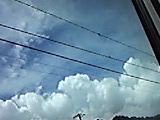
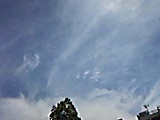
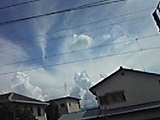
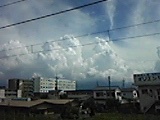
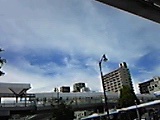
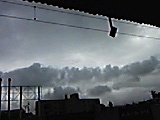
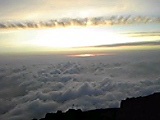
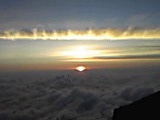 The photo was taken at 5:00.
The photo was taken at 5:00.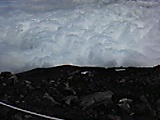
 At 16:05.
At 16:05.